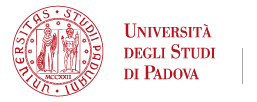

LORELLA NAVAZIO
Title: Professore ordinario
SSD: BIO/01 - General Botanics
Address: VIA U. BASSI, 58/B - PADOVA
Phone: 0498276295
E-mail: lorella.navazio@unipd.it
Curriculum
LORELLA NAVAZIO
Date and place of birth: 03/04/1969; Padova, Italy.
Current position: Associate Professor in Botany, Department of Biology (DeBio), University of Padova (UNIPD).
Education
1997: Ph.D. in Evolutionary Biology, UNIPD
1992: M.Sc. in Biology, summa cum laude, UNIPD
Positions held and research experience
2017: National Scientific Qualification as Full Professor in Botany
2017-present: Coordinator of the Biotechnology and Differentiation Work Group of the Italian Botanical Society
2015-present: Deputy Director (“Vice Prefetto”) of the Botanical Garden of Padova
2014-present: Associate Professor in Botany, DeBio UNIPD
2012: National Scientific Qualification as Associate Professor in Botany and in Plant Physiology
2000-2014: Academic Researcher/Assistant Professor in Botany, DeBio, UNIPD
2000: Academic visitor (2 months), Glycobiology Institute, Dept. Biochemistry, University of Oxford (UK)
1999-2000: Post-doctoral research fellowship, Plant Cell Biology laboratory, DeBio, UNIPD
1998-1999: European Molecular Biology Organization (EMBO) long-term fellowship (1 year), Plant Laboratory, Dept. Biology, University of York (UK) [supervisor: Prof. D. Sanders]
1997: National University Consortium for Plant Molecular Biology contract, DeBio, UNIPD
1996: European Commission short-term fellowship (3 months) (Project of Technological Priority, PTP), Institut für Genetik, Technische Universität Braunschweig (Germany) [supervisor: Prof. W. Martin]
1995: EMBO short-term fellowship (3 months), Bijvoet Center for Biomolecular Research, Dept. Bio-Organic Chemistry, Utrecht University (The Netherlands) [supervisor: Prof. J.F.G. Vliegenthart]
1994-1996: Research activity as PhD student, Plant Cell Biology laboratory, DeBio, UNIPD [supervisor: Prof. P. Mariani]
1993: Italian Association for Cancer Research (AIRC) fellowship (1 year), Mutagenesis laboratory, DeBio, UNIPD [supervisor: Prof. A.G. Levis]
1991-1992: Research activity as undergraduate student, Mutagenesis laboratory, DeBio, UNIPD [supervisor: Prof. A.G. Levis]
Research interest: plant cell biology with specific focus on plant calcium homeostasis and signalling.
Author of 36 papers published in peer-reviewed journals with impact factor, and of 4 book chapters. First author in 13 papers, last author in 8 papers. h-index: 18. Total citations: 928 (Web of Science). Reviewer for international journals (18), invited speaker at international conferences and foreign Universities (15). Participation and contribution to 42 international and 25 national conferences.
Research area
The main research activity of my laboratory is focused on the involvement of calcium as signalling element in a wide variety of physiological processes in the plant signalling network.
In particular, we are interested in the analysis of the signalling mechanisms underlying two of the most important beneficial plant-microbe interactions – the nitrogen-fixing symbiosis and the arbuscular mycorrhizal (AM) symbiosis. We are trying to dissect the symbiotic signalling pathways activated in the microbial partners by plant-derived molecules (i.e. flavonoids and strigolactones). Bacteria and fungi involved in these symbioses provide plants with essential mineral nutrients, increasing crop yields and favoring a sustainable agriculture, through a drastic reduction of the need for chemical fertilizers. The results obtained so far have highlighted how transient intracellular Ca2+ changes are used as a common “chemical language” spoken by all symbiotic partners. A detailed analysis of the molecular determinants of plant-microbe symbioses may improve, via modulation of these communication circuits, the ability of microorganisms to interact with plants and/or the ability of plants to take advantage of these interactions. Insights into basic processes underpinning communication between plants and beneficial microbes are essential to develop future strategies to improve plant nutrition and stress resistance, in order to meet an ever increasing demand on a sustainable and secure food production.
Another line of investigation concerns the monitoring of Ca2+ dynamics in plastids, unique organelles of the plant cell. Chloroplast calcium signalling is a recent field of investigation of up-to-date importance, in view of the role attributed to calcium in the regulation of photosynthesis. In this context, our research aims to unravel the precise mechanisms of Ca2+ handling by chloroplasts as well as non-green plastids, also by using genetic tools represented by mutant plants defective in putative organellar Ca2+-permeable channels. A toolkit of aequorin chimeras targeted to the chloroplast stroma, the envelope, the thylakoid membrane and thylakoid lumen is now available. Arabidopsis thaliana lines stably expressing these differentially targeted bioluminescent Ca2+ indicators are used in Ca2+ measurement assays in response to different environmental cues. The research work carried out so far has shown that chloroplasts may generate specific intra-organellar Ca2+ signals and contribute to the fine-tuning of cytosolic calcium signalling in response to both abiotic and biotic stimuli.
Proposals for thesis
The proposed thesis projects are as follows:
1)Decoding molecular dialogues in a plant root endosymbiosis.
The project aims to investigate the calcium-based signalling mechanisms activated by plant symbiotic signals in arbuscular mycorrhizal (AM) fungi. Novel genetically encoded fluorescent Ca2+ indicators will be engineered and evaluated as new tools to monitor cytosolic and nuclear Ca2+ dynamics in the fungal partner during the early stages of AM symbiosis.
2)The involvement of chloroplast Ca2+-permeable channels in plant organellar Ca2+ signalling.
The project is focused on the dissection of the role of Ca2+-permeable channels located at chloroplast membranes, by using lines of the model plant Arabidopsis thaliana wild-type and knock-out, stably expressing the bioluminescent Ca2+ reporter aequorin in different chloroplast sub-compartments.
3)Interplay of plastids and endoplasmic reticulum in the plant calcium signalling network
In plant cells plastids and the endoplasmic reticulum (ER) structurally interact through plastid envelope protrusions, called stromules, that continuously extend and retract in an ER-aided manner. The occurrence of specific contact sites through which plastids and ER may exchange not only lipids, but also ions such as Ca2+, opens up the possibility of a complex and finely-tuned Ca2+ regulation. In this project we aim to analyze the potential plastid-ER cross-talk in Ca2+ homeostasis and signalling, by using Arabidopsis lines stably expressing differentially targeted aequorin probes.
Last update: 26/11/2025





